The recent discussions on Facebook about exactly where along Stringybark Creek the police murders took place quickly degenerated into a hopeless tangle of threads and comments that became impossible to follow, and went nowhere. As a result, The Kennedy Tree report group began a similar conversation on their own page, once they had lifted their long-standing block on anyone posting to it. However it was soon obvious to them that their arguments were not prevailing there either, and so they shut the conversation down again.
So, even though nobody altered their positions, the discussions gave useful insights into the minds and the thinking of the various protagonists, and further revealed the strengths and weaknesses of their arguments. To try to untangle some of the confusion I am going to make a few posts that I hope will simplify and explain some of the main arguments .
Remember that the starting point for all these investigations is the Burman photographs of the police campsite, one of which is seen above. In this Blog Post I will discuss the way in which the photos have been interpreted.
In his report of the murders, McIntyre described what he remembered of the layout of the logs at the campsite, saying that some were lying in a roughly east to west direction, and were joined in the middle by one running roughly north to south. He also said that when Kennedy returned to the camp he returned from the north, and Kelly concealed himself behind a log and directed McIntyre to sit on it, to his left.
So now, when you look at the photo at the top of the page, its easy to orientate it because what is shown is exactly what McIntyre described. It shows someone pretending to be Kelly hiding behind a log and armed with a gun and looking to the right of the scene, towards the north, it shows someone pretending to be McIntyre, unarmed and seated on a log looking in the same direction, and it also shows another person pretending to be Kennedy approaching these two men, from the north.
Here is a very clever and helpful reconstruction made by Bill Denheld that explain what is seen in the Burman photos :
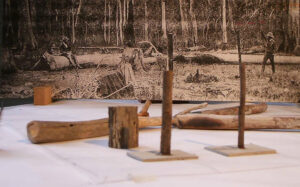
Now heres the really crazy news about the CSI team and Adam Ford, both of whom have their own different claims about where the camp is : they have both declared that Burman got it wrong. According to them, in the photos Kennedy is shown approaching from the south, and the other two are turned around 180 degree to look south when they should have been shown looking north.
According to these guys, Burman would have known these actors were in the wrong positions, and they made his photos deeply flawed, but for some reason he did it anyway. They don’t explain why they think he chose to do it like that, to make images that were less accurate, when it would have been just as easy to make them much more accurate. They just say he was a commercial photographer and didn’t care.(Mick Fitzsimons also says Burman got it wrong and claims to have his own site, but he must be very uncertain about it because he hasn’t ever presented a detailed case for this site of his like Bill and the others have)
On the other hand, Bill and the KTR group both believe that as a professional photographer Burman would have done his best to make images that were as close to what really happened as possible. It would be damaging to both his livelihood and his reputation, which depended on the quality of his work, for people to discover his images were not as reliable as they could be. Why else would Burman have gone to all the trouble of hauling himself and his gear all the way out to SBC through rough country on horseback? The argument that he went to all that trouble to get there and then just to take inaccurate images that could undermine his reputation and livelihood makes no sense, especially when it would have been very easy to make the images much more accurate. If he didn’t care about accuracy he could have much more easily recreated the scene in some convenient trees in his own back yard or in the bush just out of town, anywhere he liked. A whole lot less fuss.
So, the first step in figuring out the orientation of those photos is to answer the question yourself: Would Burman have tried to make his photographic records of what happened there as accurately as he could make them? You’re metaphorically at a fork in a road and have to decide, on the basis of what seems the most sensible choice, which one leads to the Campsite.
If your answer is no, he probably wouldn’t have tried to make his photographic records of what happened there as accurately as he could make them, then you can investigate any site you like, including the CSI site and the Ford and Fitzsimons site . Not caring about accuracy includes the possibility he might have got it right by accident…
On the other hand if your answer is yes, it makes sense to believe that Burman would have wanted to make his images as accurately as he could, then you agree with Bill and the KTR group, and with me. We all believe Burman deliberately placed his ‘actors’ facing north, and in positions that were as accurate as possible given the need to fit them into the picture, and this means that the camera was in the north east pointing south or southwest. This decision means there is no need to further investigate the CSI and Ford and Fitzsimons claims to have found the police camp site because the basis for their investigations is an unreasonable belief about Burmans motivation and a careless attitude to the accuracy of his photos.
In my next Blog post I will update my critique of the KTR claims, with reference to their recent commentary.
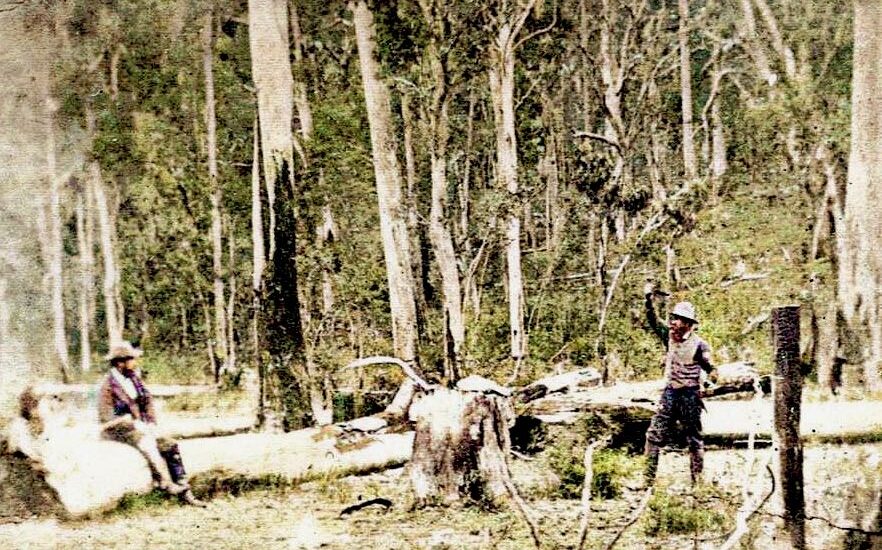
Hi David, I have never given any opinion on where the SBC murder site was, and am not looking at that. I’m just intrigued by something Keith McMenomy said in his “Ned Kelly the Authentic Illustrated History”, p. 90, that “the plate [= photo] is taken from where the police pitched their tent next to a ruined shingle hut (only the burnt posts remain)”. Then on p. 278 in the notes he said, “Burman’s photograph of SBC was produced at Kelly trial 1880 and its accuracy confirmed by McIntyre”.
Does anyone know with a source reference exactly what McIntyre said about it?
Stuart, you must be working from a different edition of McMenomy as the page numbers are different for me in the 1st edition hardback I have. At the committal hearing in August the Burman photograph was produced as Exhibit A and here is what McIntyre had to say regarding it —
“Where we camped there was an opening – a few logs being about. The photograph produced represents the place at Stringy Bark Creek where we camped.”
Hi Sharon, thanks for that; and yes, if you have the first edition hardback it is likely Ned Kelly The Authentic Illustrated Story 1984 First Edition. The one I have is Ned Kelly The Authentic Illustrated History 2001 revised Edition; the difference in the title is from Story to History. The revised one is a bit bigger and with some little things corrected here and there; but all of the same fantastic photos and references with a few more.
McMenomy is of course very Jonesian, following The Master in accusing McIntyre of perjury based on Sadleir’s 1913 Recollections in holding that McIntyre’s first statement was the one recollected by Sadleir. (He also accepted Jones on body straps.) Of course, we know that this was just massive bungling by Jones’ inability to realise (or perhaps, admit) that McIntyre’s first statement was the one in the Crown Prosecution file which Jones had read, and which McIntyre directly discussed in his memoir.
Why McMenony didn’t pick this up instead of blindly following Jones is anyone’s guess. Very disappointing.
I have a sticky note in my McMenomy that says McIntyre said that the photo produced in court was taken from the bottom left hand corner of his map. Obviously that is not from what is written on the back of the photo; but either I made it up when I wrote the sticky note (unlikely or I would have a question mark on it) or it is from testimony somewhere. If it is from testimony, that would help clear up the issue of where the camera was.
I think the most important thing sounds like McIntyre’s sketch map, the big one with the positions of who stood where and who moved where in the two phases of the attack after emerging from concealement.
Hi again Sharon, I found that quote source by working backwards from Kelvyn Gill’s Historical Record with the typed text, a great help, then to the source in VPRS 4966 Unit 2 Item 7, Beechworth statements by McIntyre etc., p. 24 of the PDF. This part of his statement was given on 6 August; then the court was adjorned to 7 August, see Kelvyn’s green book p. 416 with the Argus for that.
Next step is to read all of McIntyre’s evidence there and see if he said anything else about the photo in the Beechworth committal. Then the Melbourne trial testimnony as the photo was apparently used there too.
Hi again Sharon, next installment: McIntyre made a 46 page statement before Foster PM on 11 August 1880, within which he saith that after they had been with him about 15 minutes Kelly “went over himself close to the fire and knelt down behind the log I have pointed out on the photograph marked ‘A’. The fire was made at a place where the two logs crossed one another. It was one of those logs that the accused concealed himself behind. Byrne and Dan Kelly went into the spear grass, the other man [Hart] remained in the tent. Accused called me over to him and made me stand close by him. The log was between us. I was on the tent side of the log.”
VPRS 4966, unit 2, item 8.
Thanks, Stuart. As always you turn over all the rocks (and logs!) in search of answers. Why I remembered that first bit I told you about was because I had written a piece for Bill Denheld’s site about the little doodle/drawing on one of the working papers of the trial where the single hut was drawn and which he had wondered who had done it. That info re Exhibit A was on the same page at bottom.
That’s a great rock you happened on. I think the easiest way to do this might be reading everything in Kelvyn’s green book by McIntyre after the Beechworth committal onwards where the photo was first mentioned?
To continue: there were 2 mentions of the photo in McIntyre’s triel evidence printed in the Herald, Thurs 28 October 1880, p p2 -3.
P.2:
“We camped in a small clear spot the midst of a forest. The clearing covers about an acre or two in extent. The spot had been cleared by a number of trees falling and knocking others down. The dead logs were lying about. The photograph produced represents the place. ”
P. 2-3:
“We made the fire in the opening about twenty yards from the tent, where two logs had fallen across one another. We had one fire complete and burning at about ten minutes before 5 o’clock in the afternoon. I was then standing close to the junction of the two logs, and Lonigan was standing quite close, but on the opposite side of the fire. He would be about three yards from me (witness pointed out the positions on the photographs.)”
The Herald is not in K’s green book, which gives extracts from the Argus only for McIntyre’s evidence. It jumps to the Age for coverage of Bindon andf Smyth’s comments after the adjournment.
Here’s a good one, from the Daily Telegraph 29 October 1880. In Kelly’s trial Bindon tried it on by asking McIntyre whether the police had warrants for the Kellys in their posession.
This feeble lawyer’s trick was no more than attempt to discomfort McIntyre when giving his evidence. There was never any legal point or force behind the question, despite what many a Kelly nut has thought to see. His Honour Barry “drew the learned counsel’s attention to the wording of the warrant which was to the effect, ‘To Constable Lynch, or all other constables in the Colony of Victoria’.”
The “learned counsel” ha ha; and Bindon performing under Gaunson’s guidance. A legal clown show grasping at straws.
Incidentally, no mention of the Burman Exhibit A photograph in the Age or Argus either.
Attachment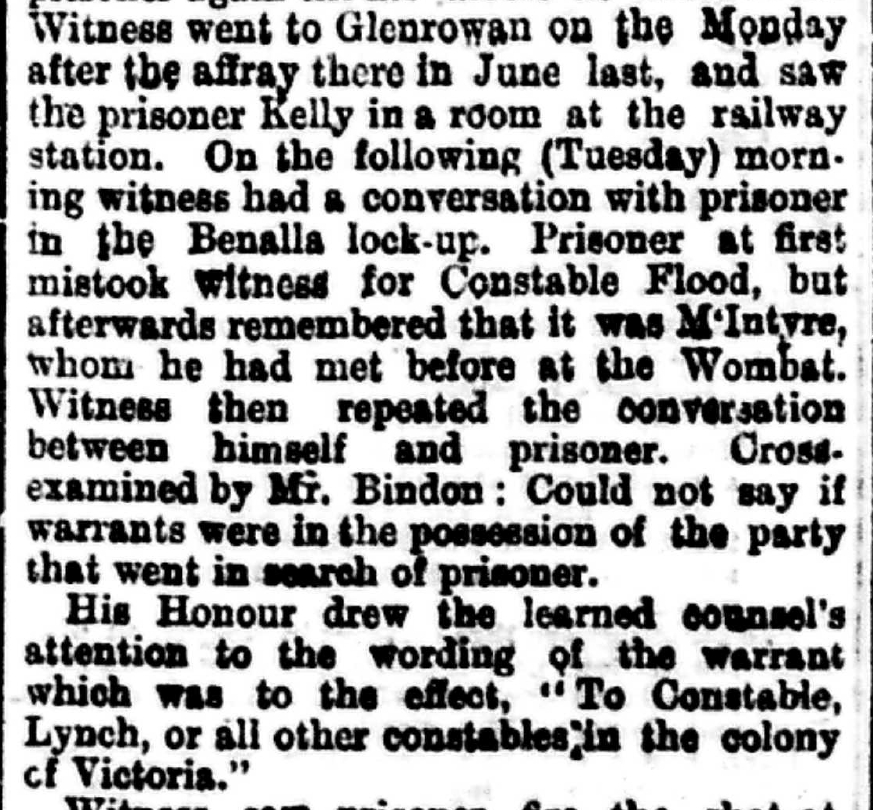
In the Capital case file in VPRS 4966 , Barry’s minutes of evidence in Kelly’s trial, p 158 of the PDF, re McIntyre’s evidence say only “Photograph of the place produced.”
Sharon and Stuart you are doing wonderful work ferreting out what McIntyre is reported to have said about the Photos and I am very impressed with what youve found.
Is it true then that all he is known to have ACTUALLY said is simply “The photograph produced represents the place. ”?? And that he ‘pointed out the positions on the photograph’??
Its of interest that after being shown the photos he was NOT recorded as expressing any concern about where the. figures were placed in them.
I am raising this because its being suggested on Facebook that McIntyre described which logs were seen in the photo, and by implication conveys a belief of his that the camera was pointing to the NE….the point being that if what he ACTUALLY said when shown the photos was effectively ‘yes thats the place’ and he didnt object to the layout in any way then doesnt that strengthen the argument that Burman had his actors in roughy the right places and they were facing north?
Hello all, I am late coming to this discussion, but my understanding is that ‘Exhibit A’ was Ned Kelly’s Burman Postcard- titled “No1 Wombat Ranges where the troopers were shot” I have covered this in my pending book to be available soon.
I add a few paragraphs here.-
” We know the Burman photo was presented to the court because the photographer made a sworn statement that he “ took the photos himself”, while McIntyre swore that –“Both photos were taken from the direction of the bottom left-hand corner” (as per his map). We can now see this was incorrect, and with this miss-orientation, Ned was not given the opportunity to show from where they came into the police camp, because the court now believed the photo was looking North Easterly.”
“The Magistrate, Judge Redmond Barry, must have been aware of the photos orientation discrepancy, but together with his police colleagues, they did not want McIntyre’s layout to be questioned. But instead, they questioned Kelly’s – Burman photo ‘Postcard’. It would appear that by the time of Ned’s trial mid- 1880, a high-quality Burman photo was presented to the court, and passed around to the jury, all while Ned only had a small postcard defined as ‘Exhibit A’ that the magistrate dismissed because he wrote on a small piece of paper pinned to the postcard- these words, – “ Doubts as to the accuracy of the scene (leading to reconstructions), perhaps been stimulated by a sense that this is a fairly unusual piece of evidence to introduce”. (The postcard is kept at the Public Records Office of Victoria)
I hope this short explanation makes sense as it’s just 2 paragraphs of 15 pages with pictures. David showed one of my model layouts, so here is a bird’s eye view of the model. I had calculated the two posts in one of the photos were about 3m apart, so this gives you a scale on the board.
Sharon’s comment above refers to this page-
http://www.denheldid.com/twohuts/mcintyre.htm
Attachment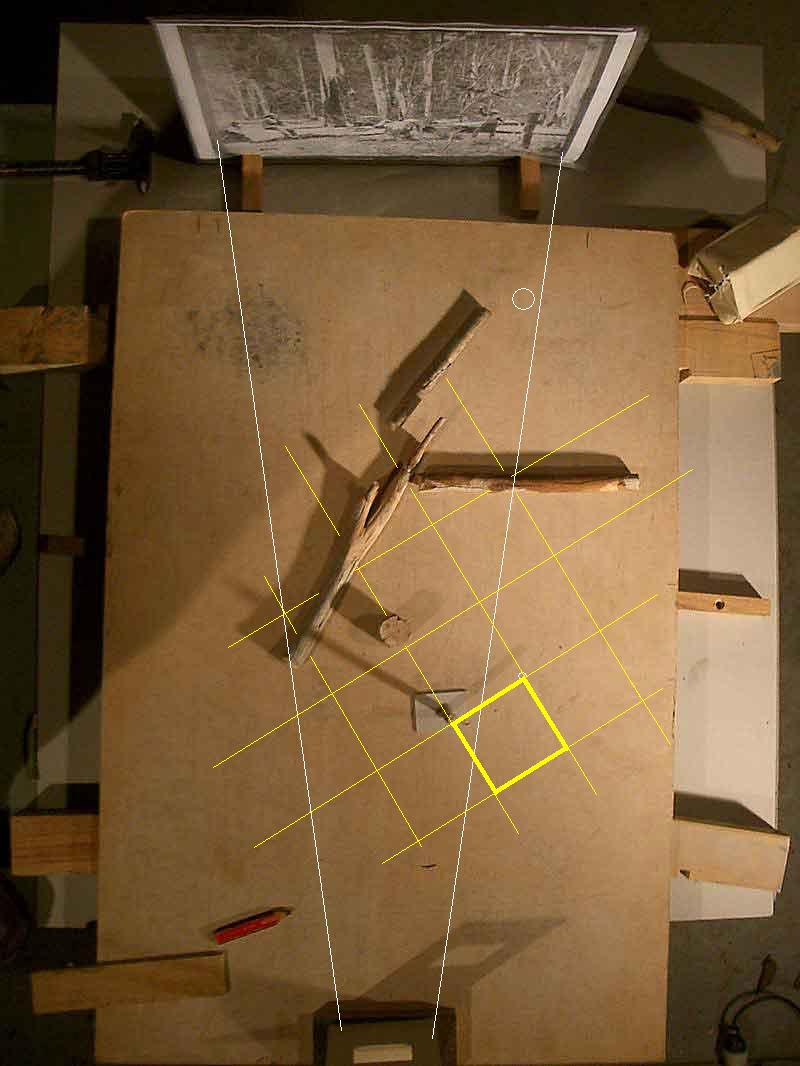
Hi Bill, I’m excited to learn you have a book coming out and am keen to buy a copy so please promote it here on David’s blog as well as wherever else! Or let us all know if we can buy through your website.
That quote you mentioned, that McIntyre swore that –“Both photos were taken from the direction of the bottom left-hand corner” (as per his map), is the one I have been searching for for over a week. Do you have a VPRS reference or other source for it that you can share?
Yes, Stuart, I saw the ref only the other day -it was as if it was common knowledge and I didn’t need to feature that, but I am sure it was in Mc’s deposition for Ned’s court case. We need to remember Mc’s final account was made 2 years after the event at SBC, and his memoirs were written 24 years later in 1902. We do not know when he drew his map that the curator of the Vic Police Museum- Elisabeth Marsden had found in the police files. I think that map mentioned from where he thought the photos were taken. !!!!
My book chapter on this subject, re the orientation of the Burman photo, will clarify why Ned was dudded big time by the authorities, which cost him his life. After all, that is what they wanted to do, set up a powerful example- don’t mess around with us in authority. That is probably why we are still discussing this today.
Attached image; Ned’s actual Burman postcard ‘Exhibit A’ to which the magistrate pinned the words -“ Doubts as to the accuracy of the scene (leading to reconstructions), perhaps been stimulated by a sense that this is a fairly unusual piece of evidence to introduce”.
Attachment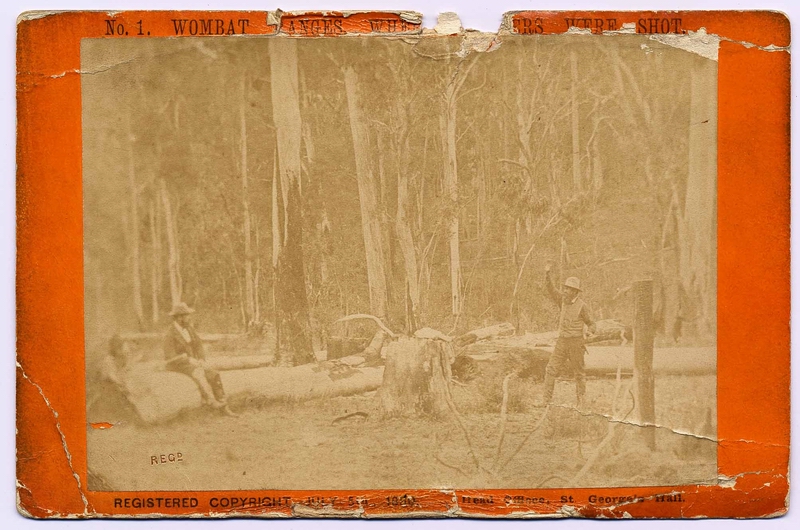
Hi Bill, I’ve been searching Mc’s various depositions in the posts above this one for him saying what you quoted, that “Both photos were taken from the direction of the bottom left-hand corner”, but haven’t found it yet. If you have an exact reference for the quote that would be great.
The map Liz found in the Vic Police Museum – the detailed McIntyre map VPM3847 – is not marked with any comment about where the camera was. I’ve attached a scan of it just so you know which map I mean (but it’s a very poor PDF copy).
Attachment Thomas-McIntyre-Map-on-A4.pdf
Hi again Bill, I think I found it on this blog in an old post of yours from 2020 here, https://nedkellyunmasked.com/2020/05/the-actual-true-story-of-ned-kelly-part-vii-the-murder-of-scanlan-and-kennedy-at-stringybark-creek/#comment-7391
” According to Keith McMenomy’s 1984 book Ned Kelly (Illustrated) shows that sketch with notation to compare the logs with the two photos- “ both were taken from the direction of the bottom left hand corner (39) ” Source ‘ From Police Dept correspondence op.cit- accompanying McIntyre’s sworn statement.”
I have McMenomy’s 2001 revised edition, but I didn’t spot that in it. I’ll have another look…
Hi again Bill, my post vanished so I’ll try it again. You gave the source as this on the blosg back in 2020 in this article, https://nedkellyunmasked.com/2020/05/the-actual-true-story-of-ned-kelly-part-vii-the-murder-of-scanlan-and-kennedy-at-stringybark-creek/ , saying
“there was a crude sketch and a detailed one. The first sketch only showed ‘two logs’ and a four men line up. No North, no tent, no creek. The sketch was used at Ned’s preliminary trial and later at Beechworth. According to Keith McMenomy’s 1984 book Ned Kelly (Illustrated) shows that sketch with notation to compare the logs with the two photos- “ both were taken from the direction of the bottom left hand corner (39) ” Source ‘ From Police Dept correspondence op,cit- accompanying McIntyre’s sworn statement.”
Hi Bill, I’ve attached the bit from your site, where it looks like the correspondence comment about the camera position was in reference to the more basic simple McIntyre skecth, not his detailed map.
I still want to locate the exact reference for that comment and read it for myself…
Attachment McIntyre-on-SBC-photos-maps-and-camera-angle.pdf
Hi again Bill, McIntyre’s small rough sketch map of SBC is in VPRS 4966, Unit 2, Item 10, the Capital Case file, page 51 of the PDF.
I still want to locate that comment, that “Both photos were taken from the direction of the bottom left-hand corner”, apparently (according to McMenomy), in “Police Dept correspondence op.cit – accompanying McIntyre’s sworn statement.”
Anyone know, to speed this up?
Stuart, I was searching online around and came upon the csi@sbc report (but, sadly without the footnotes included) where it mentioned an undated note from Sub-Inspector Kennedy giving a statement that Burman made about one of the photos used for the trial.
So, I looked in Corfield and it said Sub-Inspector Douglas Smith Kennedy was based at Beechworth and was involved in dealing with police reports for the initial trial proceedings in August 1880. So, this fits with “police correspondence” and might be a new avenue to explore. Hopefully the reports are online! Or this could be a red herring.
Hi Sharon, could it be that no-one has actually specifically researched for this before? It’s hard to believe that McMenomy wrote in his revised Authentic Illustrated History (2001) p. 90, “The plate [= photo] is taken from where the police pitched their tent next to a ruined shingle hut (only the burnt posts remain)”, which I quoted near the top of this discussion, and then in his sources note for that chapter he says, “McIntyre’s sketch in police correspondence accompaying McIntyre’s sworn statement, in Kelly Papers VPRO,” and the no-one has ever pursued this issue of McIntyre mentioning the camera position. But a lot of Kelly research is downright sloppy, so maybe I shouldn’t be surprised.
Anyway, this seems to suggest that the police correspondence accompanying the sketch is where we would look for someone recording McIntyre saying something about where the camera was positioned when the photo that was shown in the trial was taken. The sketch only appears in the Capital Case file in VPRS 4966, that I can find. There doesn’t seem to be a duplicate of it anywhere else in the VPRS files.
Could it be that Sub-Inspector Kennedy’s note about a statement Burman made about one of the photos also included a comment that McIntyre made about the photo? Surely someone out there has a complete copy of the CSI@SBC report that has the footnotes in it, that could look this up to try and find a footnoted source? Why are they apparently still charging money for a revised version of a 2012 report anyway? They could just put it online for free in the interests of historical research.
All my stuff is free online including the 7 years work I put into the Republic Myth book. I’m sick of people being prescious about “their” research. Surely if someone has a case for something they should put it up for anyone to examine? Anyway, that’s been my hobby horse for over 20 years, which is why I on purpose decided to make my historical research output free from the start and argue against all forms of academic copyright even for published works after say 5 years which is enough time for anyone to make something out of royalties if their work is commercially successful.
Sub Inspector Kennedy. Re Burman photo
VPRS 4966. Queen vs Edward Kelly: Murder File. Page 53.
Hope this helps
Hi Anonymous, thanks for that. VPRS 4966, unit 1, Item 2, the Murder File, page 53 of the PDF has the one-page note in which Burman tells Sub-Inspector Kennedy that he took the photo produced in court, of the place pointed out to him by Mr Monk; with a second note there that Monk was with McIntyre when the bodies of Lonigan and Scanlon were found. “McIntyre identifies the photo and draws attention to an upright post the remians of an old hut, see right hand corner of frame.”
However, this note page does not have the words quoted by McMenomy, said to be stated by McIntyre, “Both photos were taken from the direction of the bottom left-hand corner”, apparently (according to McMenomy), in “Police Dept correspondence op.cit – accompanying McIntyre’s sworn statement.”
So the search continues…
From my pending book, this might help. McIntyre had helped make another sketch of the scene only weeks after the shootings. Naturally, it would be difficult to capture everything in one illustration, but Mc must have spent some time with the journalist and his illustrator. There will always be a critique of the detail. If the photo was taken from near the tent, then there must be a steep slope down the creek-which there is not. This lack of slope is the weakness in all the other contended sites like the CSI and KTR group’s case.
Attachment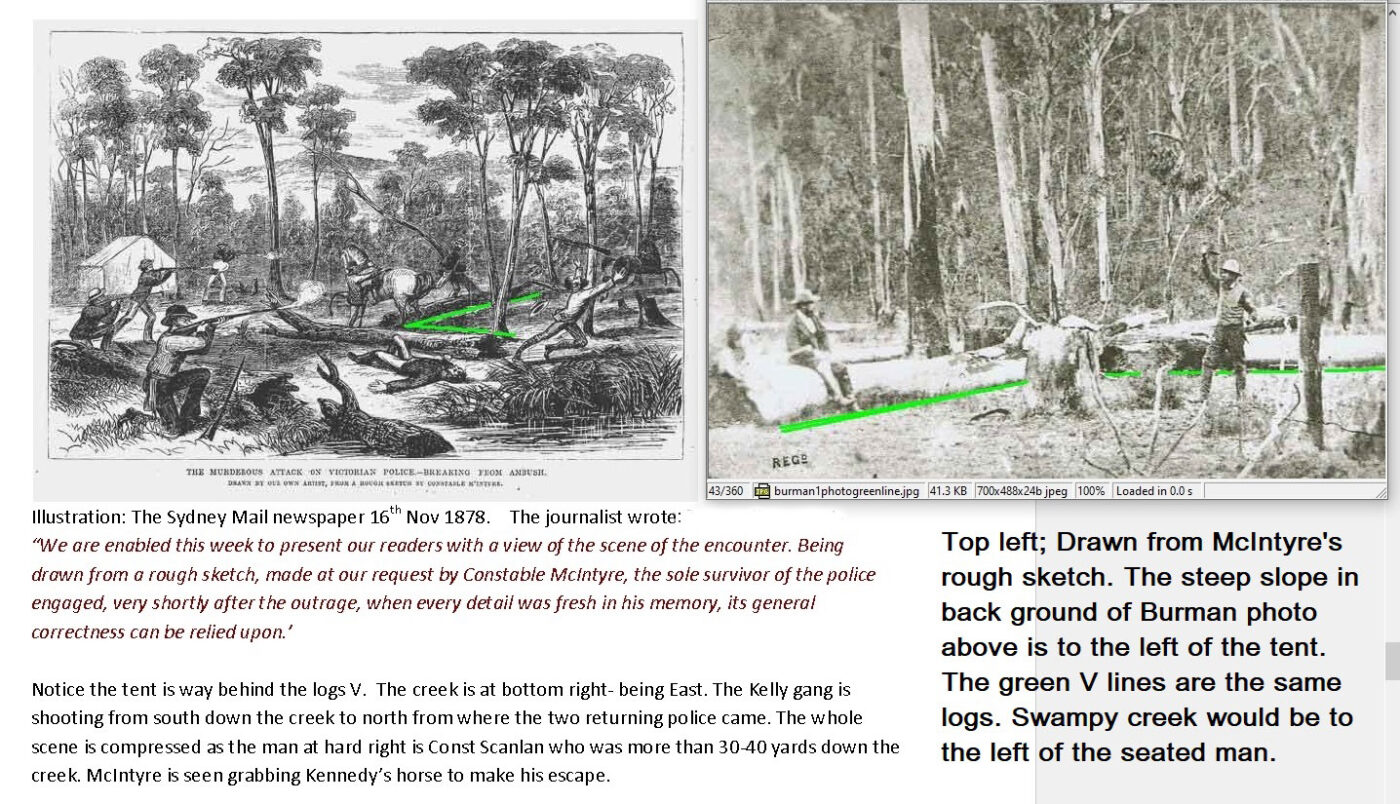
Sorry, my ref to the seated man should read- “Swampy creek would be to the RIGHT of the seated man”.
Here is another image that helps orientate McIntyre’s two logs with the Burman photo.
Attachment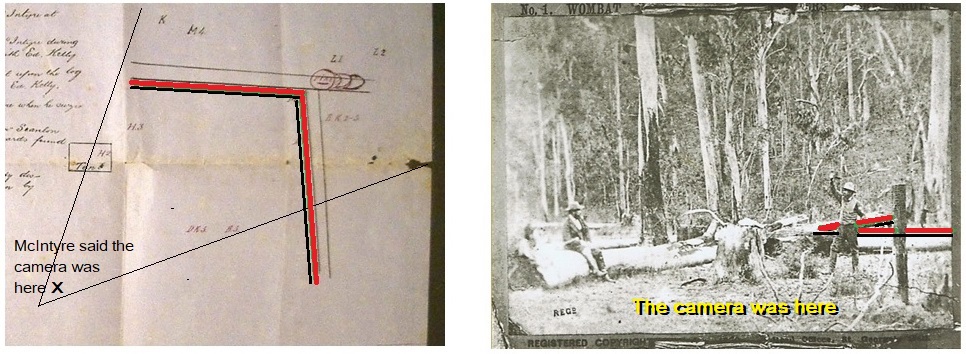
Here is another picture that shows the true arrangement of the logs according to my table top models. We can work out how McIntyre produced his detailed map layout because he drew M3 on the wrong side of the log if he was seated looking northerly. This can be supported by Mc saying Kelly was on his right – the creek side. On his map he has Kelly on his left which i swrong.
Attachment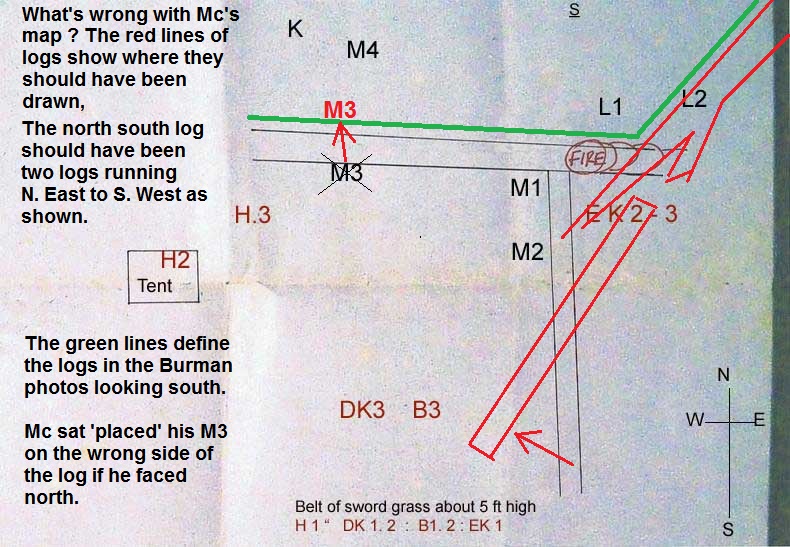
Great diagrams Bill. And a fair point about Mc putting himself on the wrong side of the log when seated though he got it right for M4.
As an aside, looking again at the photo that was shown to McIntyre : I think it would be surprising if he had looked at it, recognised it was a misrepresentation but didnt say anything. In other words, if he believed what was shown was the view from the tent, then he would have immediately noticed ‘NK’ and himself and Kennedy all were quite clearly on the wrong side of the logs. So if he agreed the photo was OK could it be inferred he accepted the view was NOT from the location of tent but from a different part of the site?
Another incidental : in the drawing said to have been made with Mc assistance : there are no stumps shown on the tent side of the logs….but theres one near Mc and the prancing pony…add that to the case for your view of the photos orientation…
M3 Where McIntyre shows where he sat upon the log is correct. McIntyre’s statement before W.Foster. P.M. Beechworth. 11th August 1880. To Mr Gaunston. Reference .… Page 438 Edward “Ned” Kelly The Historical Record. Kelvyn Gill.
“(Witness here describes by diagram the arrival of Kennedy and Scanlan) I was sitting on the log with my back towards Kennedy when he was coming up. I addressed him first when about six or eight yards away. The accused then was about ten or twelve yards at my right rear.”
McIntyre also said they camped behind a ruined hut. How can it be we have the fireplace and footprint of a hut with post holes pretty well orientated according to what primary sources state.
Not only that, there is a second fireplace only 30 feet away, and this site had been identified by Jack Healy and Billy Stewart who were local bushmen who lived and worked in the area from the 1920 to the 1980s, yet this debate continues a hundred years later because the authorities can’t cope with all the BS, so they are free to do as they like with misleading signage boards and upgrades that has cost the taxpayer more than $200,000 and is a disgrace.
Above: Stuart makes the point that all material of historic importance should not be subject to $$$, just as I have always provided my findings and research online for free. It’s fair enough that a book costs money to produce, but if someone has a strong conviction about a historic site that is important to a story they should make it freely available so anyone can absorb that information. I have always said, prove me wrong and I will gladly accept I was wrong, but to date, for the past 20 years no one has been able to show me any other sites, with proven fireplaces of huts dating back to the 1850s, nor a steep enough slope as in the Burman photo related to huts.
Attachment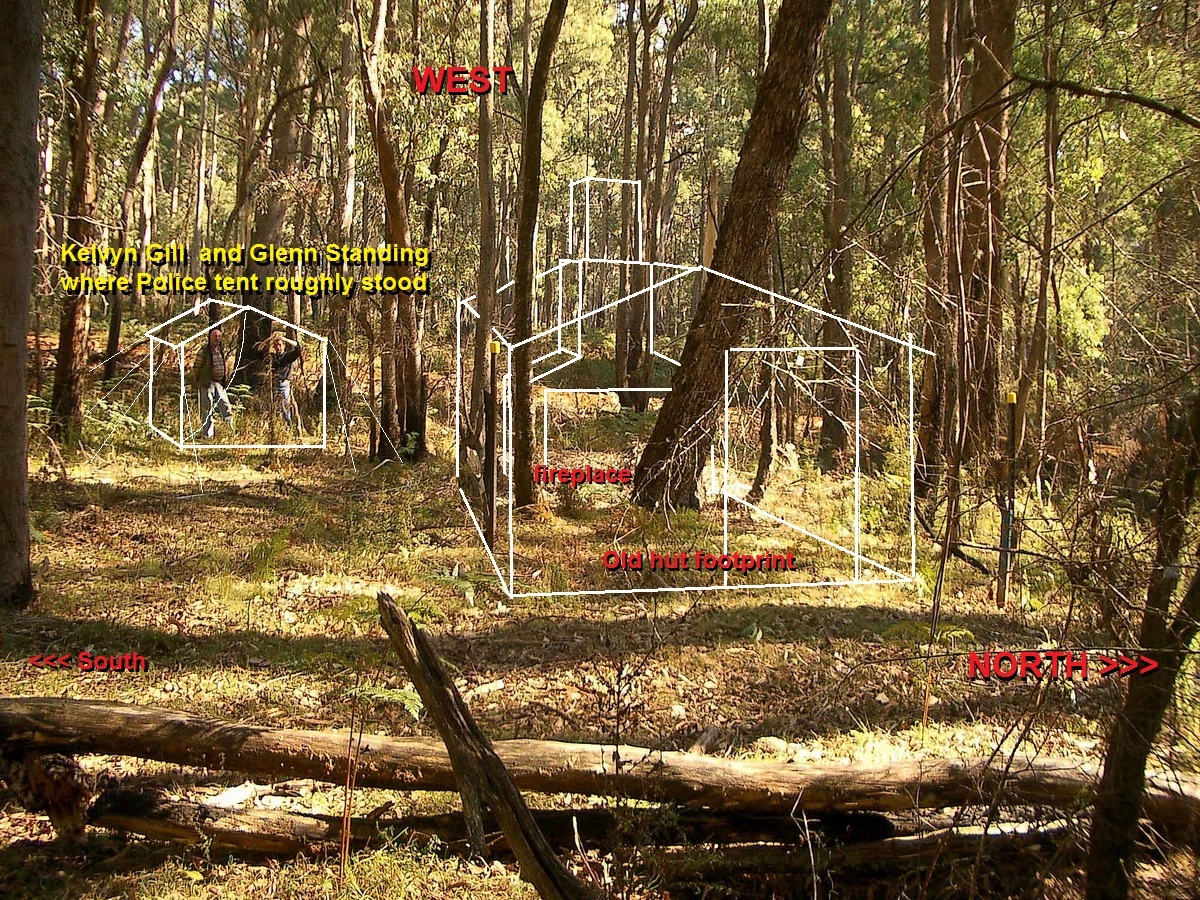
Hi Bill, thanks for all this, and I am cheerfully going to pay full price for your book when it is available as I want to help support all the work you’ve done over the years that will be in it, just the same as I was happy to pay Kelvin full price for his Historical Record both editions (green and brown) that he had to pay to get copied and bound with no guarantee of sales. I was just winging about the CSI report still being so much so many years years after it was put out! It’s OK make some money back on the publication by all means, but if people are going to engage in ongoing historical disputes surely there’s a time limit after when people should be able to access the evidence and join in without forking over their hard earned?
I see in your second post at 3:48pm above that on the detailed McIntyre map extract you have typed, “McIntyre said the camera was here, X”. That’s the sentence I have been trying to locate all week, the asme as what McMenomy said he’d found; but I still haven’t found a source reference for it. Would you happen to have it somewhere? Or anyone else?
BTW I’m not getting involved in any discussions about where the campsite was; never have, never will. I’m just keen to see what McIntyre himself said (and in this case what others in his day said that he said).
Cheers, Stuart
Hi Bill, I noted that you have said that according to McIntyre it was his assertion the photo was taken looking North East, and facing those two logs.
Would you please provide the source reference of this statement. Thanks in advance.
RE. https://ironicon.com.au/Q-and-A-for-best-bloody-man.pdf. Appendix 11.
Hi Bill,
Ref: https://ironicon.com.au/Q-and-A-for-best-bloody-man.pdf. Appexdix 11.
Here you say that it was McIntyre’s assertion that the Burman photo was taken looking towards the North East.
Stuart has asked you politely several times now if you can provide the reference for the quote you made.
“Hi Bill, I’ve been searching Mc’s various depositions in the posts above this one for him saying what you quoted, that “Both photos were taken from the direction of the bottom left-hand corner”, but haven’t found it yet. If you have an exact reference for the quote that would be great.”
“Yes, Stuart, I saw the ref only the other day -it was as if it was common knowledge and I didn’t need to feature that, but I am sure it was in Mc’s deposition for Ned’s court case.”
If you are sure of it then please provide the reference.
Thanks, Glenn
Hi Glenn, the words quoted by McMenomy, said to be stated by McIntyre, “Both photos were taken from the direction of the bottom left-hand corner”, apparently (according to McMenomy), in “Police Dept correspondence op.cit – accompanying McIntyre’s sworn statement.”
McMenomy is very good with his references, so surely more people than Bill must have looked into this over the years? That’s two people – McMenomy and Bill – who seem to have come across this at some point, so I am still optimistic that if it is there someone will find it. I will look more on the weekend.
Hi Stuart, I would have thought Bill would have had it on hand if it is to be included in his critique of McIntyre within his pending book. But perhaps I am mistaken. So will just have to wait and see.
I have also been searching for it but have found nothing to date. So the search continues.
The reference I am also interested in finding is where McIntyre asserted that the photo was taken looking towards the North East.
Hi Anonymous, that’s exactly what I’m looking for. I have no interest in arguments about where the campsite was. I’m only interested in whether McIntyre actually said what it’s been claimed that he said, with a reference, so I can see if that matches well with his two sketches; the rough sketch and the detailed map. To me it makes sense that since his detailed map has compass directions marked on it, and he had been to the site both at the murders and again to retrieve the bodies, and also identified the Burman photos as being of the place, that he would recall where the camera must have been was to take those photos. I don’t care where the site was. All I’m interested in is the consistency of his testimony on a matter that haunted him for the rest of his life. If he did say that the camera was positioned by the tent, and if it matches his maps, that’s good enough for me.
Hi Stuart, that last post was from me, my apologies I forgot to put my name to it.
It’s a pleasant change to have some common sense come into the discussion. I have always found McIntyre’s testimony to be a good match with his detailed diagram. If the references referred to can be found then that should settle the matter.
Glenn
This is all connected with a larger argument, that many people have alleged that McIntyre committed perjury in his testimony about what happened at SBC, in a deliberate attempt to deny Kelly a possible defence case of self defence if Lonigan drew and aimed his pistol at Kelly before Kelly shot him. It rests entirely on a belief that McIntyre provided a first statement of what happened to Supt Sadleir which was allegedly the account given in Sadleir’s 1913 memoir, which partly lines up with what Kelly said happened.
This is all nonsense as McIntyre’s first statement which was unlocatable for the Beechworth committal hearing was subsequently located and put in the Melbourne trial Prosecution brief. That is why Gaunson and Bindon did not pursue a self defence case in Melbourne, because there was no inconsistency in McIntyre’s series of testimonies. What we have is an incorrect recollection by Sadleir 40 years after the event, and a false claim made first by Jones in 1967 that what was in Sadleir’s book was McIntyre’s first statement; disproved by the actual dated first statement on the prosecution file. What fooled Jones was the mislabeling of that as the second statement; but when he must eventually have read McIntyre’s autobiographical memoir which explains clearly what happened and why the self defence argument was a non-starter, he was incapable of accepting the truth and stuck to his accusations of McIntyre as a perjurer, then accused Sadleir of knowing complicity in that perjury. What an arrogant useless prick.
McIntyre was highly educated as his memoir makes clear. His memories and testimony were highly consistent over time. I’m sure that if he did happen to state that the camera was in a certain position, then it was.
Well not exactly Stuart…..I now dont think he ever said it, but if it turned out that he did, it can still be legitimate to ask was he right?
Hi David, of course! But if it turns out that he did say it, and if it matches his maps, is it reasonable to challenge it? Let’s wait and see as the search continues.
After some 100 years of lies and unhistorical fictionalised mythmaking from Kenneally’s Inner History (1929), Brown’s Australian Son (1948) and Jones Man & Myth (1967); Short Life (1995, continued 2003, perpetuated 2080), with Fitzpatrick lampooned and maligned mercilessly, McIntyre and Sadleir repeatedly and savagely accused of perjury, anyone critical of the Kely clan and descendants overtly threatened with violence (Kenneally onwards), and criticism of St Ned hostilely dismissed as based on “extreme selectivity, exaggeration blatant omission, factual error and occasional fabrication” (Jones 2003), we learned over time that Kenneally, Brown and Jones were the fabricating mythmakers whose works are riddled with naive idealism along with hefty doses of extreme selectivity, exaggeration blatant omission, factual error and relentless fabrication.
The Kelly myth that had stretched 100 years with a remarkable absence of anything resembling critical scholarship died in 2012 with the publication of VPRO archivist and meticulous researcher Ian Macfarlane’s The Kelly Gang Unmasked, for which he was subjected to a relentless campaign of abuse far worse that any criticisms I have made of any of the above pro-Kelly authors. There is even a Facebook page that I have been sent numerous screenshots from, entirely devoted to sullying Macfarlane’s work. Even if I had facebook I wouldn’t waste my time on such anti-intellectual drivel by commentators who clearly haven’t read it or certainly haven’t been able to follow and understand it.
A new factual narrative has taken root. No-one can pretend to be up to date with Kelly studies if they have not carefully read Macfarlane’s book that started the critical revolution, and David Dufty’s Nabbing Ned Kelly to see just how much has changed. Peter FitzSimons’ Ned Kelly (2013 ) ignored Macfarlane’s book because, as David found out when he spoke with FitzSimons in a bookshop promotion, Jones had told him not to bother reading it. As a result, FitzSimons swallowed and regurgitated all the old cobblers rubbish about a Kelly republic and a revolutionary movement that existed only in Jones’ head since the late 1940s, as I traced in my Republic Myth book. Many ordinarily rational people have fallen for this ludicrous historical fabrication. They are a cult with a guru, a wise leader who saw things that no-one else had ever seen, even fooling supreme court judges and other legal eagles with his amateur bungling, selective quotations and misrepresentations of numerous historical documents as I illustrated in detail in my Ned Kelly’s Shooting of George Metcalf paper.
For my trouble I too have been frequently abused online since my Redeeming Fitzpatrick article; more frequently since my Republic theory demolition book. I was also smeared by Jones questioning my motivation in print; so yes, I remain pissed off by that. But not silenced. The half a dozen testimonials for it by some of Australia’s best historians, on the back cover and in the irntroduction, made it all worthwhile.
No, the old narrative is blown apart. It continues to attract views largely due to the skillful scripting of the old 1980 Last Outlaw miniseries, but there are lies and fantasy fabrications every couple of minutes. Contrast that with the 1 hour movie Stringybark (2019), the first accurate Kelly movie based on fact instead of fiction. A brilliant and highly watchable (and historically accurate costume and equipment-wise) production that gives the lie to so much nonsense that has persisted for so many years about the Wombat Ranges murders. Everyone who has any interest in the Kelly story should see it. The Kelly gang went from stock thieves to cold hearted killers. As Joe Byrne said to Aaron Sherritt’s mother when he shotgunned her son to death in front of her and Sherritt’s young bride, his heart was truly stone. They were indeed Australia’s historically worst and most notorious bad guys, and that is the only way they should be remembered now in my opinion.
And I’m still looking for that alleged comment about the camera position for the Burman photos said to have been made by McIntyre.
Attachment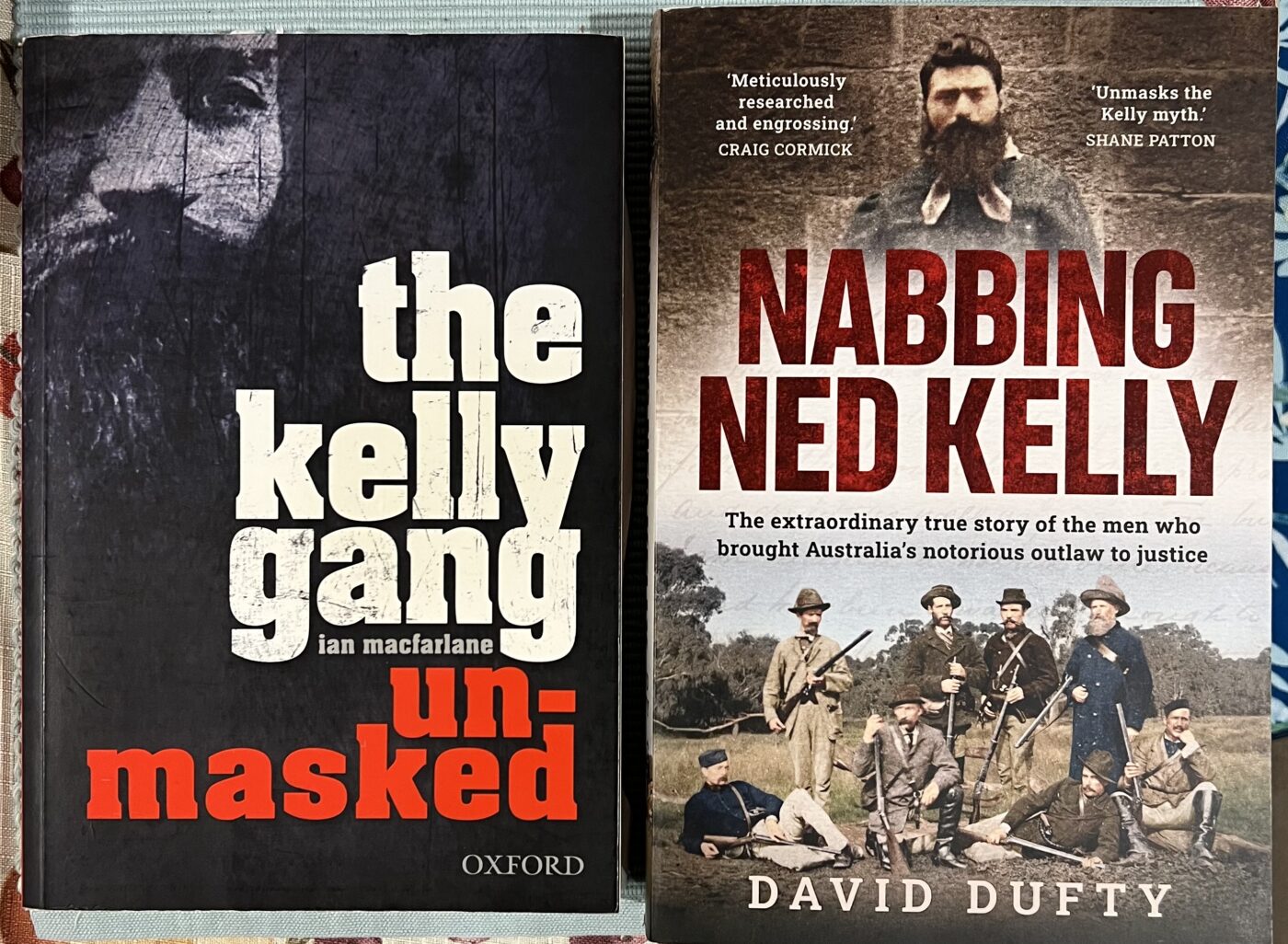
Hello Glenn, Yes I will when I happen to come across the wording again……
At. some point – and now would be a reasonable point, in my view – the search for evidence that McIntyre said the camera was pointing to the North -East will have to be called off, and the conclusion accepted that he almost certainly never said such a thing. The fact is that if anyone in the CSI camp ever saw such a statement it would have been a dream come true for them, it would never have been forgotten about but would have been a huge feature in the argument for their claim to know where the Police Camp was, and in their refutations of Bills claim that the Two Huts site, not the CSI site was the true site of the Police camp and the place where Lonigan and Scanlon were murdered. And lets not forget that the CSI team includes Kelvyn Gill, the man who produced the Definitive Record and a man who must have read almost everything it is possible to read. If McIntyre ever said the photo was taken looking north east, Kelvyn would have found it I am certain . The CSI mob have been scouring the record for over ten years…..
What we have though are two references to the photograph by McIntyre – one in which he affirms that it does show the police camp and the other, which is more interesting to me, in which he points to the figures depicted : “witness pointed out the positions on the photographs.” Its NOT recorded that he objected to where the people were positioned , and I think thats significant because if they were in the WRONG positions wouldnt he have said so?
Finally I get to the bit that I just cannot go past : the idea that Burman would have pointed his actors in the wrong directions when it would have been just as easy to have them in more accurate places and looking in the right direction. To me its ridiculous to propose he went all that way to make a photo of the event and then screwed it all up by ignoring what he knew about where they should have been looking and for no benefit to anything at all, had them all positioned wrongly . If we thought that he didnt know where they were looking then that would be understandable but we know he did actually know exactly where the bodies were and where the gang approached from and the direction from where Kennedy and Scanlon returned to the camp.
It seems people will swallow any absurd proposition if it helps to undermine the Two Huts site.
But David, there was a point that lasted decades where hundreds of deluded lunatics devoted thousands of hours searching for a declaration of a republic of north-eastern Victoria and swearing on their sainted mother’s graves that it surely existed and even that a theatre critic had actually seen it!!! I’ve just seen McMenomy repeating that very republic claim on the same page where he mentions the Burman photograph. And yet it was a fantasy given birth by a spoof in a jokes column from 1900, revived in the 1940s as I’ve shown and reeled them in hook 🪝 line and stinker!
So let us not rush to dismiss the search for a claimed comment by McIntyre about where the camera was positioned too hastily. It will take time to review all the police correspondence in each of the four VPRS 4966 files that have any statements by McIntyre in them, given all the different documents and handwritings. I have a lot of other demands on my time and can no way be pressured to do it all yesterday or surrender! No, I shout, it will take as long as it takes to read all of them looking for that one sentence. And even then I might be tired (like tonight) and simply miss it even if there. So the search continues until I’ve read the lot, in my own good time.
Only after that could I hazard any guesses about why Burman positioned his actors where he did. What we can possibly suggest about that by comparison of the photos with the detailed McIntyre map is that if the photo was taken from the tent site, McIntyre is seated at M3; but where he actually talked with Kelly on opposite sides of a log was at M2 and EK2, over at the right hand log; and that the arriving policeman should in any case be north of the logs well back in the background. So if McIntyre did say the camera was near the tent site, then the photo can show the actual site of the murders as McIntyre stated, but with the actors placed within that scene for the photo as dramatically illustrative rather than literal.
McIntyre was in 4 different places at different times as marked on his map. The photo picked one point in that time, the point at which McIntyre sat on a log as ordered while waiting for Kennedy and Scanlon to return. This possibility won’t make anyone happy by the sound of it, and depends entirely on finding the McIntyre comment about the camera position if it exists. But at the end of the day Burman went there to photograph the place and sell postcards. We can say for sure that one thing is wrong: the photographic party had horses and yet the policeman actor is on foot. McIntyre did not find it necessary to highlight this when identifying the photo as showing the place, because the statement was that it showed the place.
So I think the search for the alleged McIntyre comment should continue since 2 people say they’ve seen it, and see if it turns up or not after a patient careful search.
Here is another reference, though not the Holy Grail of references (just teasing there) about the camera position. In VPRS 4966 Unit 1 Item 2 (Queen vs Edward Kelly, the ‘Murder File’, there is a further statement by McIntyre taken by Sub-Inspector Kennedy on 21 July 1880, which finishes with a note on page 41 of the PDF in somwhat hard to read handwriting that as best I can see reads, “The witness [i.e. McIntyre] identifies a photo of the ground where Lonigan and Scanlon were shot and the Burman photographer Bourke SH will be summoned to prove it.”
As I said, this appears to be the wording. Can anyone confirm whether it does say exactly that, or correct my transcription?
Hi David, so far I have read various bits of 4966 Units 1 and 2 almost at random, and have now started again systematically, reading Unit 1 Item 1 (nothing) and am halfway through Item 2, up to p. 41 as above.
The other files listed as having McIntyre statements that might be accompanied by police correspondence are Items 6, 7, 8 and 10 in the attached list. They are all big files. So unless anyone else is wiling to pick one and go carefully through it, I could be still going at Christmas!
As I said somewhere earlier, I have never been involved in any discussions about where the campsite was and really couldn’t care. I have been to SBC and to me it was just another bit of bush. I’m only interested in what happened there as best can be worked out from what records we have. Having said that, I would like to know if anything McIntyre may have said about the photo matches up with his two maps or not.
Even if he did say the photo was taken from the tent site and it matches his maps, that doesn’t tell me personally anything about where exactly that took place. But it would help as evidence of the coherence of McIntyre’s memory of the murders, which seem remarkably consistent in all his various statements right through to his 1900 memoir.
Attachment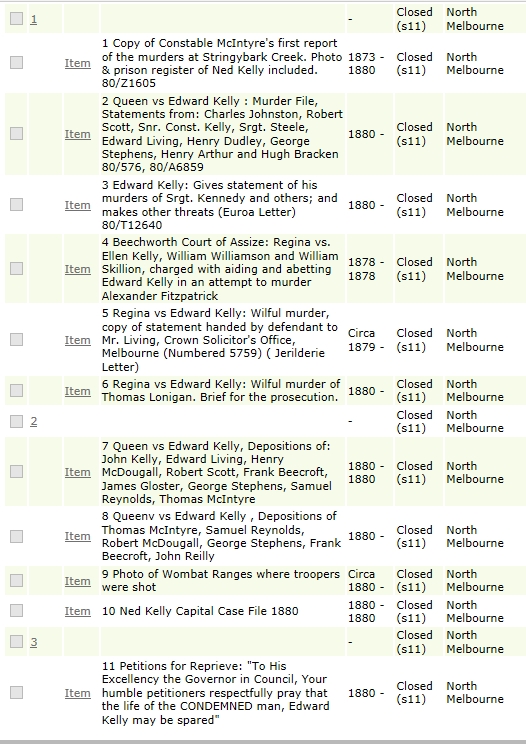
Hi Stuart I admire your persistence. A good find. ( I hadnt realised I was logged out when I posted this before which is why out came up as Anonymous)
This latest finding is a quote Ive seen elsewhere, possibly in one of Bills documents and it intriguingly SUPPORTS my view of where the photo was taken from, namely the place where Lonigan and Scanlan were shot. This is in contrast to the claim by CSI rep Glenn Standing and others that the image is of the space in front of the tent on the opposite side of the logs from the open space where Lonigan and Scanlan were killed.
hi David, I replied to that previous post when it was Anonymous with a long comment about where I was up to with the VPRS 4966 files and included an attachment scan of the document list. Have you still got that in your in box? It looks like it was deleted when you replaced your earlier post with this named one as it was online earlier. I didn’t keep a Word copy of it.
Sorry about that! Here it is:
Hi David, so far I have read various bits of 4966 Units 1 and 2 almost at random, and have now started again systematically, reading Unit 1 Item 1 (nothing) and am halfway through Item 2, up to p. 41 as above.
The other files listed as having McIntyre statements that might be accompanied by police correspondence are Items 6, 7, 8 and 10 in the attached list. They are all big files. So unless anyone else is wiling to pick one and go carefully through it, I could be still going at Christmas!
As I said somewhere earlier, I have never been involved in any discussions about where the campsite was and really couldn’t care. I have been to SBC and to me it was just another bit of bush. I’m only interested in what happened there as best can be worked out from what records we have. Having said that, I would like to know if anything McIntyre may have said about the photo matches up with his two maps or not.
Even if he did say the photo was taken from the tent site and it matches his maps, that doesn’t tell me personally anything about where exactly that took place. But it would help as evidence of the coherence of McIntyre’s memory of the murders, which seem remarkably consistent in all his various statements right through to his 1900 memoir.
Attachment VPRS-4966-Document-decriptions-from-Index.jpg
http://nedkellyunmasked.com/wp-content/uploads/2023/08/VPRS-4966-Document-decriptions-from-Index.jpg
Hi David, I have finished reading VPRS 4966 Unit 1 Item 2, the Q vs EK Murder file, and there is nothing further about teh Burman photograph the has not already been quoted on this blog page.
There is something strange: the last statement in that file is Const Hugh Bracken’s statement, which is three pages long, starts of page 77 and ends on page 79, the last page of the PDF file. However the statement looks incomplete. It ends with a broken sentence: “He called Dan into a” then it breaks off. It looks like it was supposed to continue on tehnnext page, but tehre is no next page in the PDF. It would also be the only statement anywhere that just ends mid sentence and without the statement-taker-signing off and dating it.
I therefore think that some of the Murder File is missing from the end of it. Where is the continuation of Bracken’s statement? Did the VPRO not scan all the documents belonging to the Murder File?
McMenomy 1984 would have to have consulted the actual original archival paper copy of the murder file as this was long before digitisation, unless it was a microfilm copy. Was there ever a microfilm copy? Were there pages in the end of the murder file then that went walkabout at some time since?
Maybe there was more in the paper murder file than what has been PDF’d, and maybe the elusive comment about the position of the Burman camera was on some now missing document in the missing section of the murder file?
Does anyone else know anything about this mysteriously abrupt end of the Bracken statement at the end of the murder file? Is soem of teh file missing? Is this a question to raise with the VPRO?
Maybe Dee/David is correct in saying that McIntyre never said it and that is why it cannot be found in the archives? This might be completely out of left field, but I was looking for something unrelated to this inquiry in the Mcmenomy book and I just happened to notice that generally when something is a direct quote coming from a person it is either in quotation marks or the text is italicized. I then looked again at the “corner” statement, and it has neither quotation marks nor is it italicized. Maybe this means absolutely nothing and is just a red herring, but it just stood out to me. Perhaps Bill or Stuart or someone can find the source of the original quote and settle this once and for all. I surely don’t want to delve too deep and get all caught up in it as SBC is not my area of expertise and I have other fish to fry.
Hi Sharon, do you have the first edition 1984 Illustrated History where that talk about the McMenomy reference to the camera being at the tent site seems to have come from? That was what Bill quoted from on his website, and I put the link to that page in my post of 27 August at 7:18pm above. Maybe there is some more detail in his references there.
I have the second (revised) 2001 edition, Authentic Illustrated History. McMenomy says p.90 that “the plate is taken from where the police pitched their tent next to a ruined shingle hut (only the burned posts remain).” All his notes on p.278 say about it is a reference to Australian Sketcher Nov 1878 for his quotes by the photographer, and that Burmans photo was produced at Kelly’s trial and its accuracy confirmed by McIntyre. But the bit about the quote re the location of the camera being taken from correspondence accompanying McIntyre’s statement in the police files is missing from McMenomy’s 2001 notes. Why?
Does the 1984 first edition have any more info? Is this just a long garden path? Anyway it’s good to have a refresh into the VPRO PDFs!
Stuart, yes, I have the 1984 hardback first edition. I have taken a photo of the pertinent bits from it and have sent them to your email as I know you like to have eyes on the exact text when sourcing.
Hi Sharon, there’s nothing in my email yet and it’s not in the junk mail either. If you could please try again; or if they are JPGs they would upload to the blog so everyone can see the reference?
Oh, sorry, thought I had hit send but see it was still in my drafts. Just sent over.
Thanks Sharon! I’ve put them in a PDF and attached it so anyone else can read it. Unfortunately it doesn’t add more to what has already been quoted earlier in this blog, but it is good to see a picture of what McMenomy wrote in his 1984 edition as there could potentially have been more there.
Attachment McMemony-1984-on-Burmans-camera-position-at-SBC-with-note-39.pdf
Should anything be made of McMenomy writing that the diagram was THOUGHT to be drawn by McIntyre? That phrasing seems to suggest there was some doubt in his mind…if there wasnt he would have written that it WAS drawn by McIntyre….oh dear…
He states also that his source for the claim that the photos were taken from the bottom left corner was ‘Police department correspondence op.cit. accompanying McIntyres sworn statement’
So did he previously QUOTE from that Police east correspondence or just cite it previously?
(I am away so have no access to my McMenomy ATM)
Hi David, I don’t think it makes any difference that McMenomy may only have “thought” the drawing was by McIntyre given that we now know it was, as he seems to have proceeded by treating it as thought it was.
Logically he must have quoted from Police department correspondence previously in his reference notes as he wrote “op. cit.”, for the source being “already cited”. That doesn’t help much as back in the 1980s his reference was likely just “KP, VPRO”, the same as in his later 2001 edition, an abbreviation for “Kelly Papers, VPRO” with no further file reference given.
Looking in the same chapter notes I see that there is a prior case of the Police Dept Correspondence op cit being mentioned, it is in relation to the identity of the Lloyds. So, no bearing on the McIntyre sketch or corner quote. I am still pondering on the lack of italics and quotation marks for the corner remark, does that possibly mean that McMenomy was the one saying the part about the camera position for the following two photos and not McIntyre? Maybe someone has seen the direct McIntyre quote in the archives where he himself expressly says that and can prove me wrong in that line of thinking. In other words, was McMenomy just giving the citation for the sketch itself?
Hi Sharon, I think you’ve cracked it. In the 1984 McMenomy comment under McIntyre’s rough sketch McMenomy says of it, “The position of the logs can be compared with the two photographs following, [the Burman photos], of the camp; both were taken from the direction of the bottom left hand corner”. Then McMenomy’s reference note 39 for this says “From Police Dept Correspondence accompanying McIntyre’s sworn statement”. (The rough sketch map is in VPRS 4966 Unit 2 Item 10 (the Capital Case file) p. 51 of the PDF.)
It is looking like as you proposed that McMenomy’s reference is about the sketch map and not about his comment as to where the camera was positioned. As you pointed out, there are no quote marks or italics on his comment about the camera position. I agree it is also possible to read his comment as his own conclusion or assertion about where the camera was positioned when he says “both [photos] were taken from the direction of the bottom left hand corner”. And that now turns out to be a statement of the obvious: the bottom left hand corner of what? The photos look straight ahead from wherever the camera was. His comment can’t logically mean that the photos were taken from the bottom left hand corner of the photos! It can only mean the photos were taken from the bottom left hand corner of the sketch map that he is commenting on.
If we run with this for a moment and check his 2001 revised edition, he says p.90, “The plate is taken from where the police pitched their tent next to a ruined shingle hut”. This in turn seems to rest on him noting on p. 89 that the sketch was “Thought to have been by McIntyre”, then “Compare the position of the logs with the following [Burman] photographs of the camp.” So again, it may be a firming of his 1984 conclusion about where the camera was positioned rather than anything McIntyre himself said (or never said) about where Burman’s camera was positioned.
The other possible clue is his reference to the Australasian Sketcher November 1978 for comments by the artist who accompanied Burman’s photographer. The artists makes some comments there about the sketch of the scene attached below, which I pieced together from the centre of a two page spread, hence the rough dark vertical line in the centre where the two screenshots joined up along the fold of the newspaper. The artist says p. 134,
“On the right of the picture is the separ grass in which Kelly and his companions concealed themselves when calling on Constables Lonigon and McIntyre to bail up. The two troopers stood at a fire made at the burnt end of the log shown in the middle of the engraving, and Lonigon fell a few yards away from the fire. The two dark posts in the centre are the remains of a burnt digger’s hut. When Kennedy and Scanlan were heard approaching, Kelly knelt behind the butt of the fallen tree near the stump of the right hand, and set McIntyre on his right. One of the others concealed himself in the tent, and two made for the spear grass. Scanlan was shot near the tree in the background, between the stump and the fallen tree.”
If there is not enough clarity in my joined-up JPG scans, you’ll have to look at the original newspaper scan online. There is nothing more about the attached sketch in that Australasian Sketcher article.
The result of all the above is that it now seems unlikely that McMenomy quoted the comments that “both were taken from the direction of the bottom left hand corner” and “The plate is taken from where the police pitched their tent next to a ruined shingle hut” from anywhere, but they were rather his hypothesis about where the Burman camera was positioned based on his reading of McIntyre’s sketch map. Hats off to you, Sharon! It has been an interesting quest, which I can now park
Attachment AS-23-11-1878-pp-137-138.pdf
And here it is as a JPG
Attachment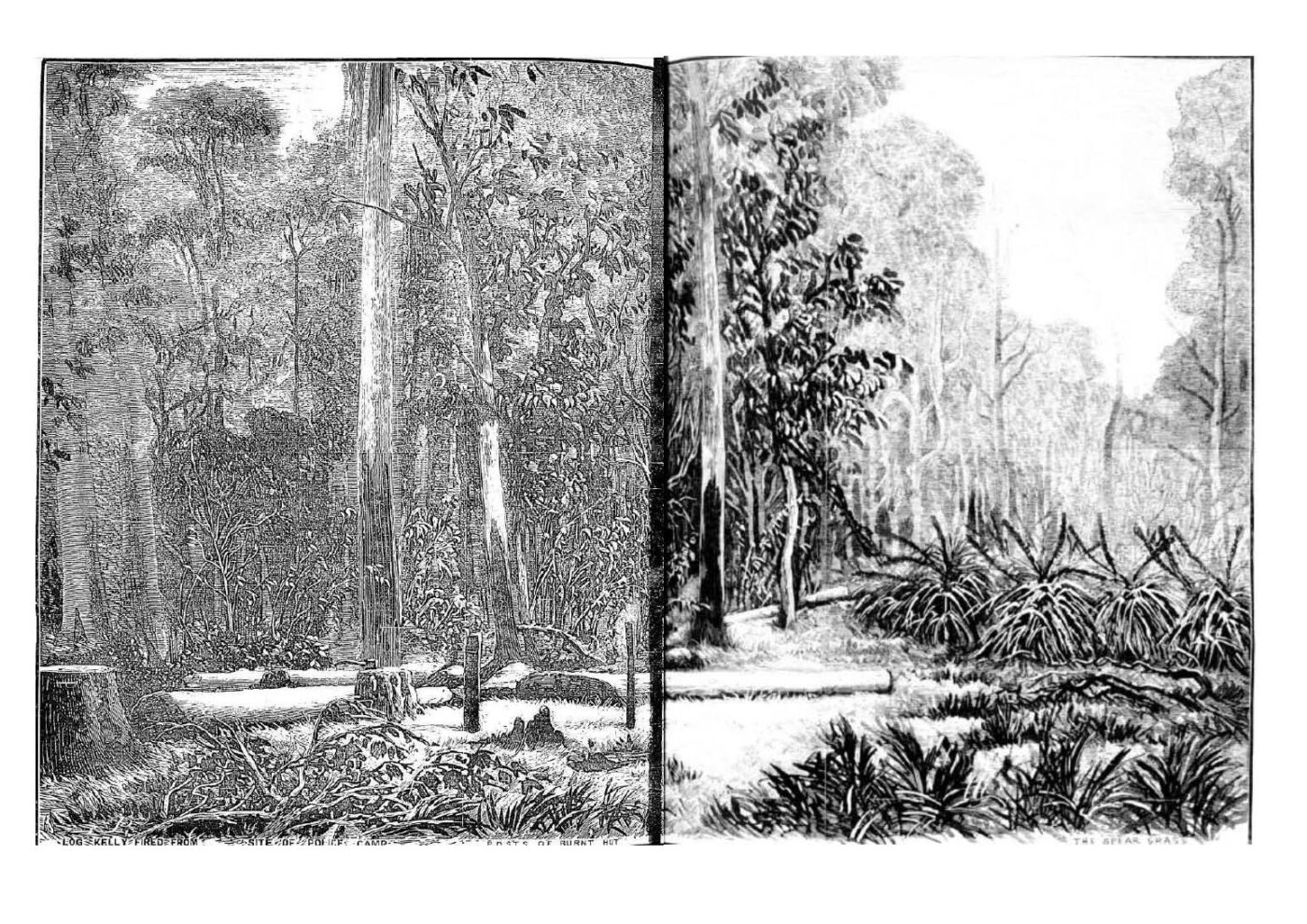
Hello Stuart, seems to me the artist had trouble drawing the slope.
The image was drawn using the Burman photo No2 while we need to use Burman No1, ( the post card) but you will see why opponents of the two huts will want to ignore the slope such as the ‘KTR group’, the ‘CSI @ SBC’ as well as Fitsy and Bob Mc on their Facebook pages.
By ignoring the slope and confusing the readers they hope they will win.
Attachment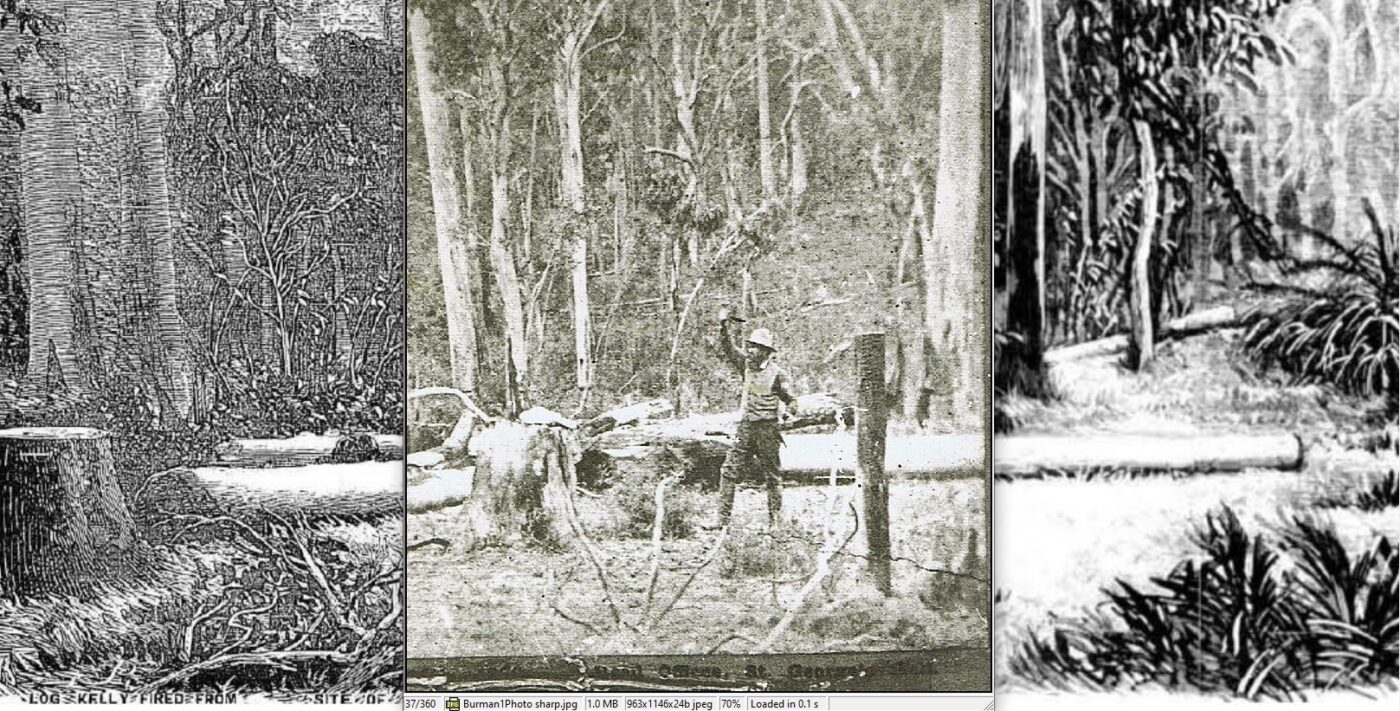
Hi Bill, a great overlay there, but I am not going anywhere arguments about the SBC site as I simply don’t have any relevant expertise. All I am interested in is the consistrency or not of McIntyre’s statements.
Just one thing – I don’t know that the Australiasian Sketcher artist used any of Burman’s photos – No 1 or 2 or some other one/s not turned into postcards in his sketch. The AS says he accompanied the photographer, and he did a number of other sketches at SBC in that same AS November 1878 issue, so I’m thinking that as with many of the other AS sketches he would have done a set of reasonable sketches there then worked them up more back at the studio for the plate engraver. Could he have referred to a photo as well? I don’t know.
So you may well be right about the sketcher not getting the slope that appears to be at the rear in the photograph correct in his sketch, but again that sort of visual analysis is well beyond me. I’m just sticking to trying to find whatever documentation can be located about what McIntyre wrote or drew himself. That’s the question Sharon raised – do we have it all yet? I don’t know; maybe not so far, or maybe there is nothing more to find.
Why dont the site sleuths comment on the description given by the Heralds reporteer about the camp site and whether it fits the two huts site or the csis site or somewhere else along the creek. This is one of the primary pieces of evidence which has never been commented on I believe.
Two photos used on cards sold to the public are only one piece of the puzzle.
Hi Anonymous, I assume this question is for people sleuthing where the campsite was, so they can or probably have discussed it. The most recent posts here have been by me and a couple of others trying to work out if McIntyre ever said anything about where Burman’s camera was placed. I personally couldn’t care if the site was in Gippsland!
Stuart, I may be way off base and may be proved wrong, but at least I threw that theory out there for others to ponder on. All along I was thinking Mac had said it just like everyone else and that it was a now lost or undigitized report others saw during a PROV visit in person, but then the lack of quotation marks/italics thing made me start to wonder. Still, someone might come forward with the reference to it, so we remain open to all possibilities. And, yep, I am with you, I don’t care where the site was, but leave that to others who have a passion for it.
Hi Sharon, I think I will email PROV this week about why VPRS 4966 seems to end with an incomplete statement; maybe there was something undigitised or overlooked. I’ve asked a couple of things before and it can take a while for them to respond. But I’m in no hurry, and will post whatever they tell me in the fullness of time…
Hi Sharon and others, FYI I emailed PROV tonight as follows:
In VPRS 4966 Unit 1 Item 2, the Queen vs Edward Kelly Murder file, there seems something unexpected about that file when it is downloaded as a PDF.
The last statement in that file is Constable Hugh Bracken’s statement, which as presented is only three pages long, but it is clearly incomplete. The statement starts on page 77 of the PDF and ends on page 79, the last page of the PDF file.
Bracken’s statement ends with a broken sentence: “He called Dan into a”, and then it breaks off. It seems certain that the statement continued onto a further page or pages, but there are no further pages in the PDF of the murder file.
Further reason to doubt that it is a complete document is that it would be the only statement anywhere in the Kelly documents collection that ends at tehn ottom of a page in mid-sentence and without the statement-taker-signing off and dating it.
I therefore think that some of Bracken’s statement, and maybe more content from the Murder File, is missing from the end of the PDF.
Where is the continuation of Bracken’s statement? Did the VPRO possibly not scan all the documents belonging to the Murder File? Was some of the original paper documents file overlooked or misplaced when the Murder file was scanned?
Was the Murder file ever microfilmed; and if so, were there more than the 79 pages that constitute the current PDF preserved on microfilm or miicrofiche? I submit that this would potentially be the quickest check on completeness; but if a microfim copy also ends abruptly after 79 pages then that does not solve the problem.
In that event, I suggest that a physical check of the original Murder file VPRS 4966 Unit 1 Item 2, the Queen vs Edward Kelly documents is warranted to see if more of the file exists.
As I mentioned, it may take some time to get a reply, but I will post whatever the result of my enquiry is.
With hundreds of Kelly enthusiasts interested in site locations, ‘who wrote what when and where’, archive citations, references, etc etc, on this blog page alone, there have already been more than 11,000 words written about photo orientation, but hardly any about exactly where photographer Burman took his photos at Stringy Bark Creek.
It surprises me that people are so interested in verbal descriptions to identify a site, when one photo tells it all.
By this we could say one photo is worth ‘eleven thousand words, but I won’t because there will be more words to come.
In the 1800s a photo could not be printed in mass production on a printing press, so an engraver needed to have his subject photo in front of him (called a ‘collodion’ printed photo). He would use a sharp pointed scriber to scratch lines onto a copper plate. The scribe lines would be filled with ink and the ‘flat copper surface’ cleaned free of ink. The plate and paper were pressed together transferring the ink lines to paper. Later to speed up the process for printing the original engraving lines were printed on to a zinc plate and the areas between the lines were etched away with acid. This allowed the original drawn lines to be raised above the plate so the printing machine could roll black ink over the etching ‘high lines’ and thus creating a perfect replica of the first engraving.
There is no doubt the Australian Sketcher used the Burman photo No2.
As Stuart noted the engraver was present when Burman took the photos because he made observation of the remains of a huts fireplace which in the photo is hard to make out, but he did show in his engraving.
Attachment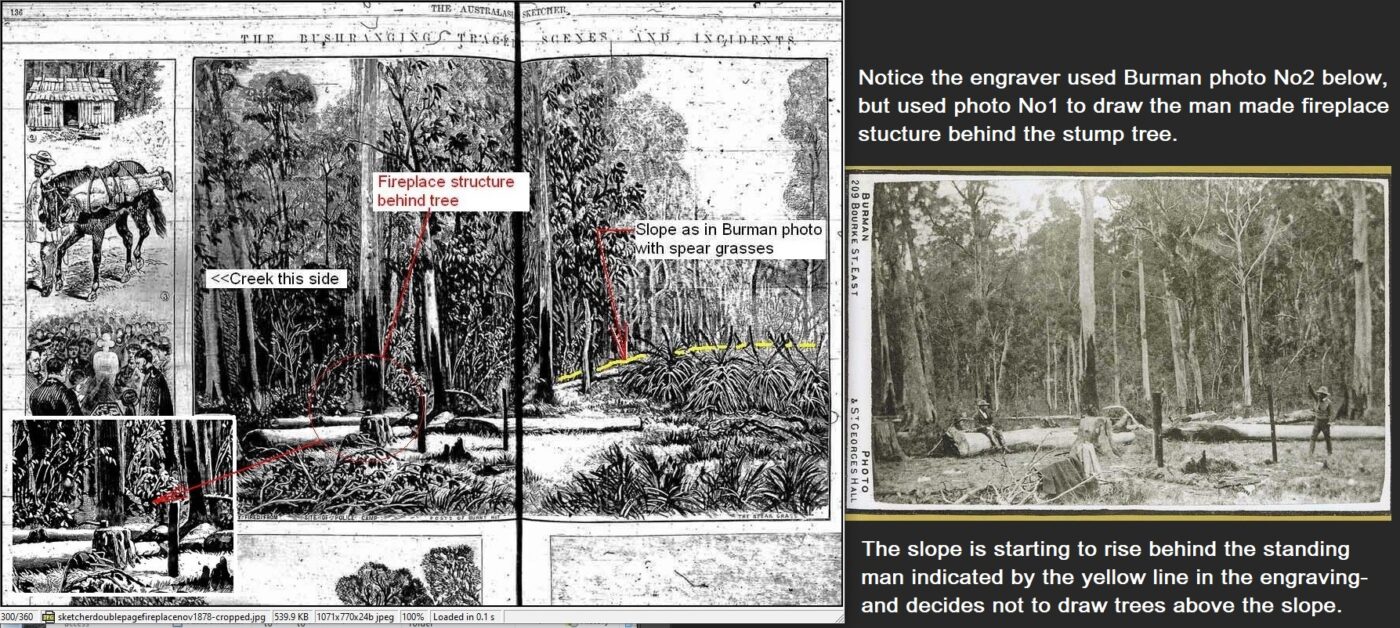
Hi Bill, that’s very interesting how they worked. Could the sketcher possibly have used a hypothetical third photo that was taken further back than Photos 1 & 2 (the postcard photos), to give the wider panorama of his sketch that became the AS engraving, than what seems to be the more limited frame of the photos, especially on the right hand side? Both photos here don’t range as far to the right as the engraving?
Burman photo No1 and the Australian Sketcher
Attachment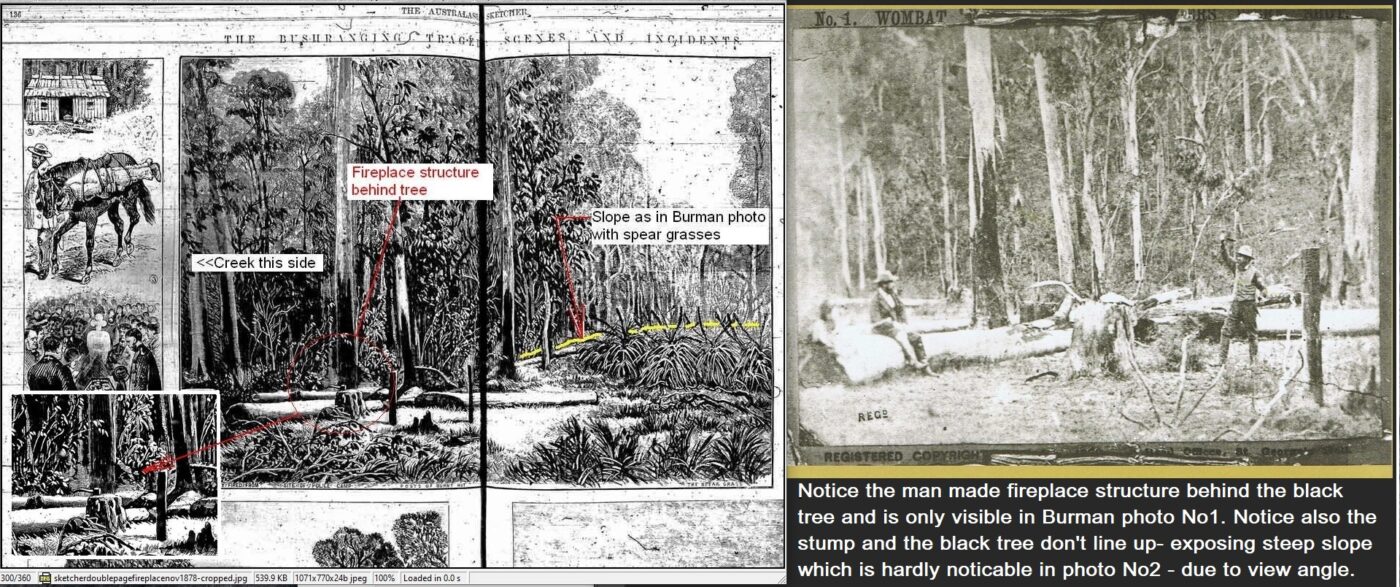
I should have mentioned that Glenn Standing, a team member of the CSI@SBC team that I appointed as a member of the ‘SBC Symposium’ because he was an expert historical analyzer of the Kelly story. He pointed out his observation of the fireplace in Burman photo No. 1.
Here is my confirmation image that I created in May 2010.
Interestingly, no other SBC site contenders have ever found nor shown any evidence of any fireplace locations anywhere along SBC since September 2002, when I came across the fireplaces of two huts. There is no issue about where McIntyre indicated from the Burman photos were taken, the proof is in the two huts fireplaces, the light and shade with a steep slope in the 1878 photos. And we can thank Glenn for his observations.
Attachment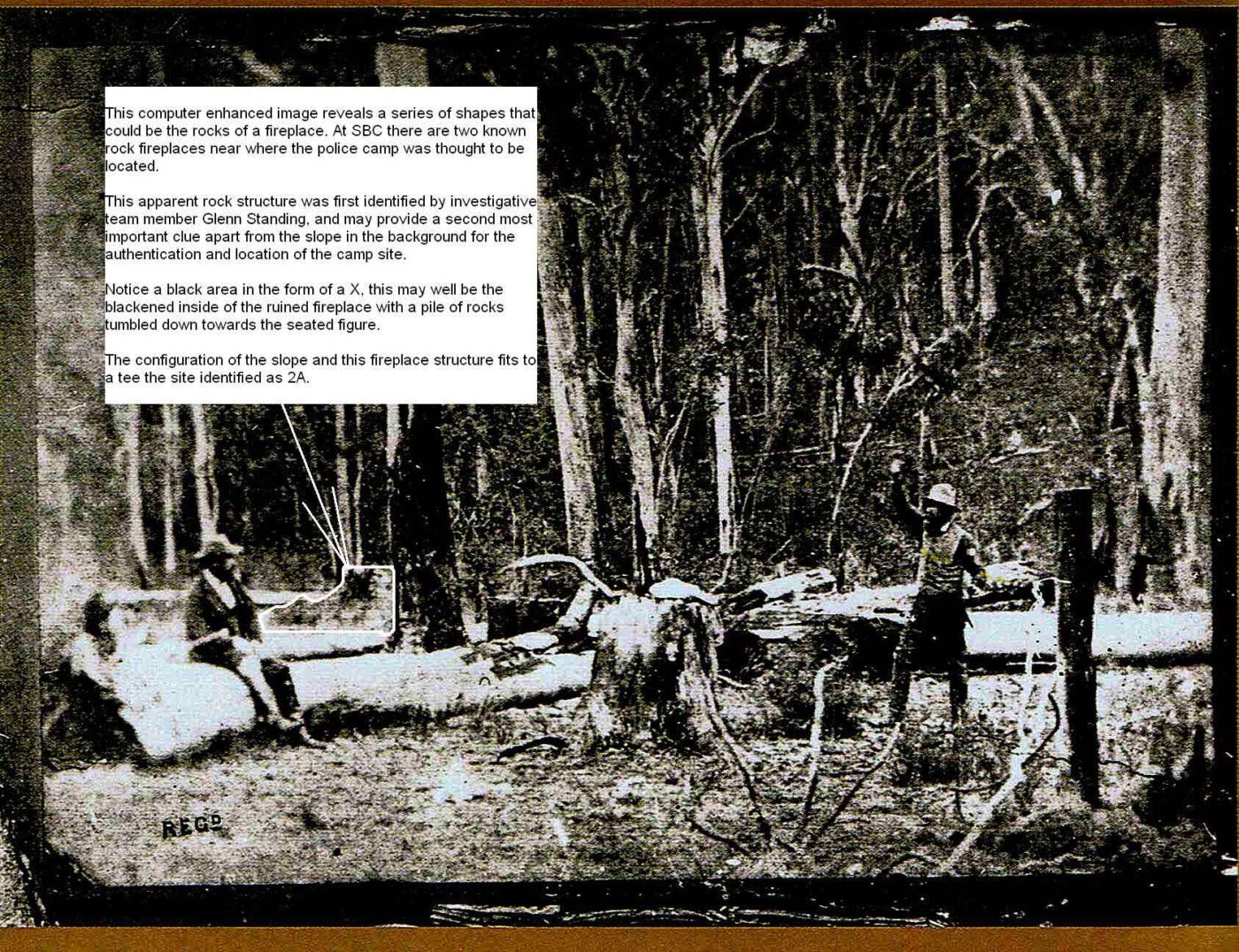
Hi Sharon and others, VPRO confirmed to me today that the last page of Bracken’s statement was indeed missing from the PDF of VPRS 4966 unit 1 item 2, and that that was the only image missing from that file, and that the missing page image will be uploaded to the website shortly.
I’m guessing that means quite soon.
I have to commend you Stuart for your doggedness in pursuing the answer to the question about what McIntyre said about the Burman photos.
Now that you’ve completed such an exhaustive search, is it NOW time to conclude as you and Sharon have been suggesting that this was simply McMenomys opinion, that it WASNT based on any actual evidence but was an educated guess?
Unless and until evidence to the contrary comes to light, I believe we should accept that no such statement was ever made by McIntyre and our discussion about photo orientation should continue on the basis of. other arguments.
Hi David, golly gosh no, that would be recklessly premature! I’ve only searched VPRS 4966 (the Crown Law Dept file) items 1 (McIntyre’s report from Mansfield) and 2 (the Murder file), but there are still items 6 (Prosecution brief), 7 and 8 (both containing a statement by McIntyre), and 10 (the Capital Case file) to go.
I agree that the clues we have indicated the Murder file and I couldn’t find anything about the Burman camera location in the correspondence accompanying any McIntyre statements there, so manybe it is a lost cause. But as they say,
This is my quest, to follow that star
No matter how hopeless, no matter how far
To fight for the right without question or pause
To be willing to march into hell for a heavenly cause…
That was a quick reply from them. Glad you got onto them, Stuart. “Soon”…there is that word again. ; (Fans of The Chosen will get that reference)
😂😂😂👍
I think I can beat them uploading it with this PDF of the missing page they sent me!
Attachment VPRS-4966-Unit-1-Item-2-Bracken-statement-p-4.pdf
Perhaps this letter from PROV re VPRS 4966/PO which was sent to me around 20 years ago, and may not be what we are looking for, but maybe the missing page was the F C Burman declaration that he took the photos. No mention of McIntyre saying from where the photos were taken, just that he identifies the photo and draws attention to an upright post- the remains of an old hut to the right-hand corner of the picture.
Attachment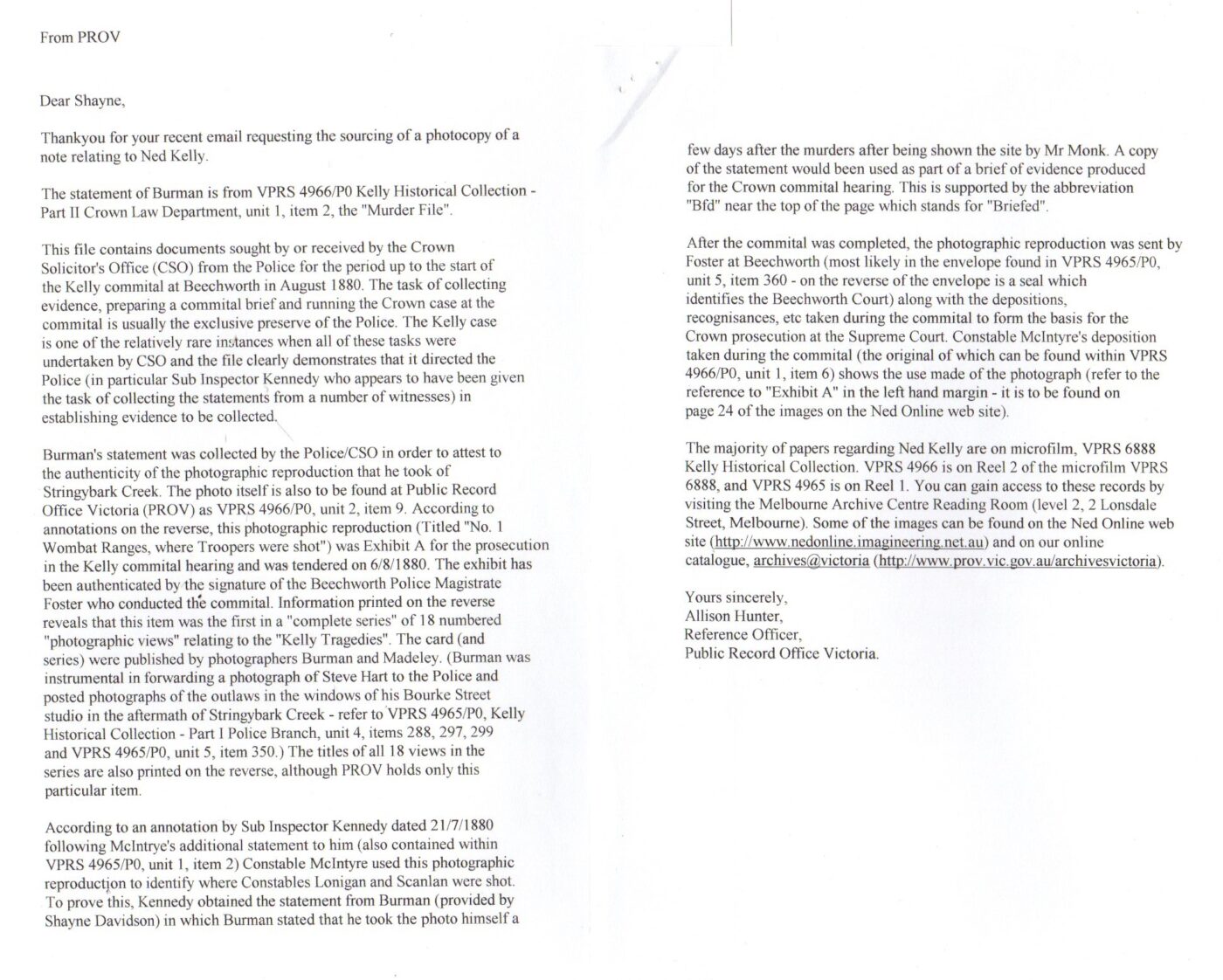
Hi Bill, the letter is interesting but as you say doesn’t mention anything about McIntyre saying where the camera was.
However, in the note by Sub-Inspector Kennedy shown in your post belaow, from VPRS 4966, unit 1, Item 2, the Murder File, page 53 of the PDF, Kennedy says, “McIntyre identifies the photo and draws attention to an upright post the remians of an old hut, see right hand corner of picture.”
Perhaps McMenony inferred from this in combination with the McIntyre sektch map that the camera had been at the tent site…
I am coming around to David’s suggestion that the quest for McIntyre being reported by McMenomy as saying of the Burman SBC photos that “both were taken from the direction of the bottom left hand corner” and “The plate is taken from where the police pitched their tent next to a ruined shingle hut” should be abandoned. It seems rather more likely as we were speculating above (triggered by Sharon noticing the curious lack of italics or a source reference in McMenomy’s notes) that these comments were both McMenomy’s hypotheses based on his interpretation of McIntyre’s sketch map in combination with the photos.
Nobody is looking for the Declaration anymore either Stuart….but one day if it turned up, or if the McIntyre quote ever turns up then we will have to have a rethink.
I am going to write a new Blog Post summarising where have got to. Stay Tuned.
The Declaration was an obvious dead duck in the first place; if there had been anything JJ Kenneally would have been onto it 40+ years after those events and 20+ years after Federation. Plus there was nothing anywhere else in any other Victorian social, political or folk history to even hint at it. It was so obviously such a colossally stupid idea that demolishing it was only a matter of ordinary spadework. It just took a long time time to shovel away the large mountain of BS.
The claim for an unsourced quote from someone who heard something from McIntyre is totally different, but I think that as it is looking like McMenomy deduced it from a sketch and a photo rather than encountered it anywhere, it can be ignored unless it turns up as an authentic source reference. I will keep it in mind for the rest of the files in VPRS 4966 as discussed, but no urgency anymore.
Scanned image accompanying the above letter- was F C Burman’s declaration – signed DS Kennedy — — — —
Attachment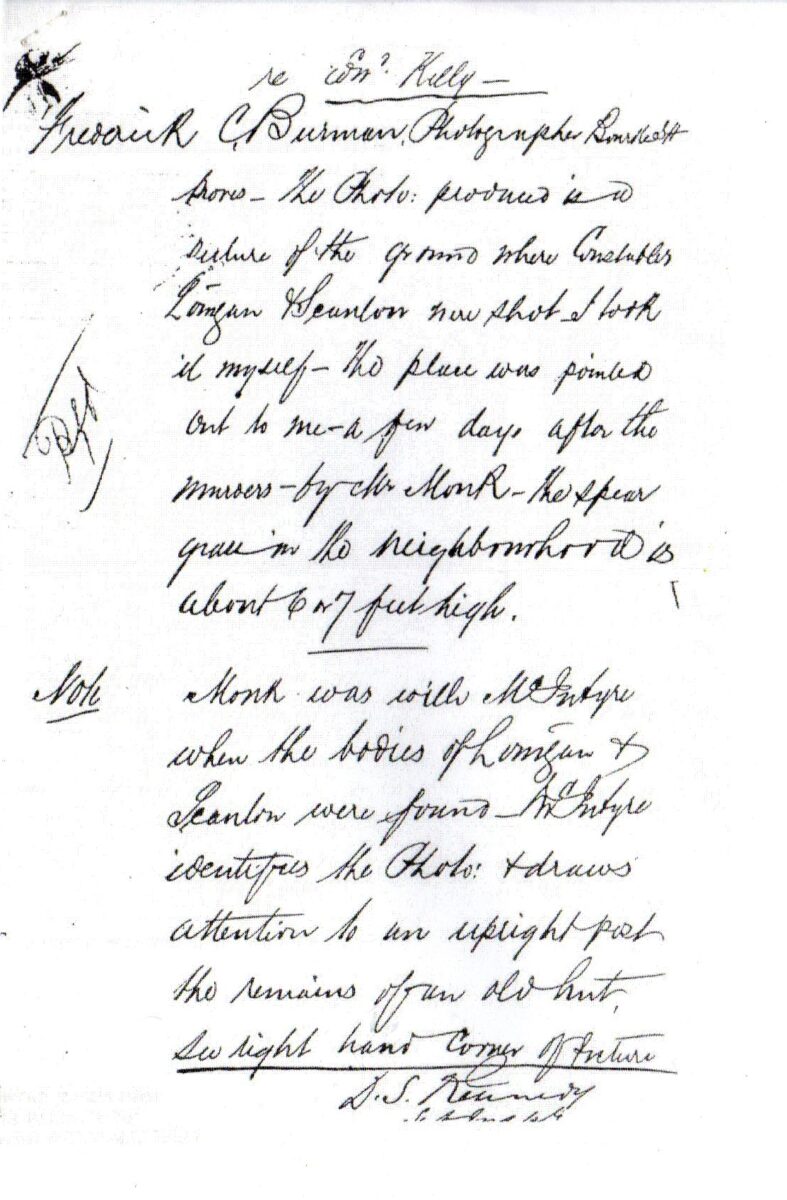
Hi Bill, thanks, that is the note that is now numbered VPRS 4966, unit 1, Item 2, the Murder File, page 53 of the PDF.